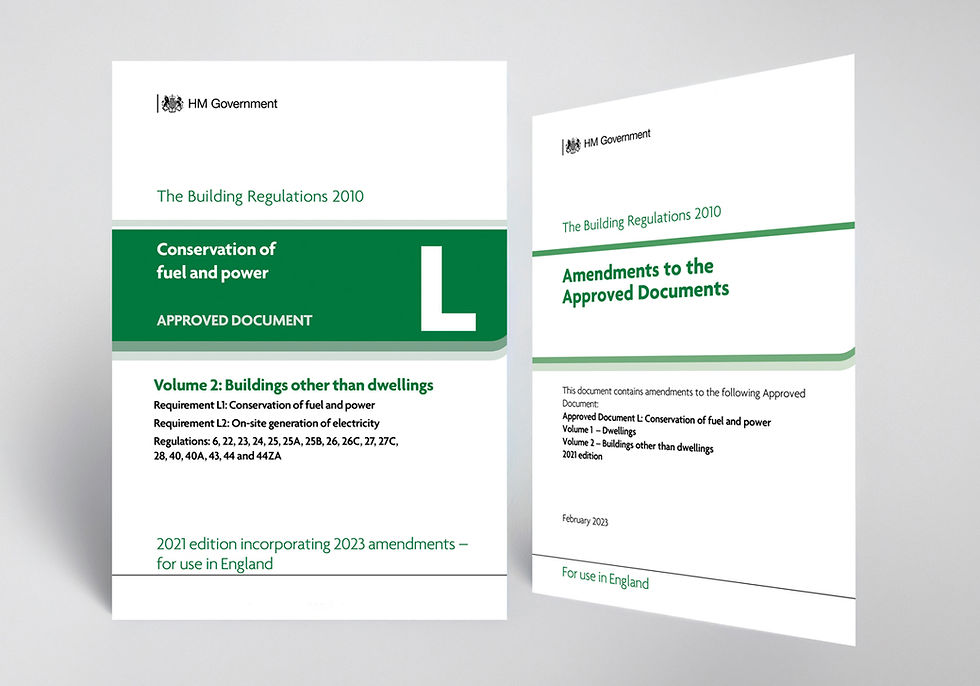What Are the New Part L Changes?
- info1864854
- Apr 18
- 3 min read
Updated: May 4

The Government has made important update to Approved Document L reflecting a strong push towards lower carbon emissions and greater energy efficiency across the built environment. These changes, effective since June 2022 with transitional arrangements lasting until June 2025, are a key stepping stone towards the full implementation of the Future Homes Standard. In this blog, we'll take a closer look at what's changed, why it matters, and what it means for developers, contractors, and homeowners.
Why Update Approved Document L?
With the UK's legal commitment to achieving net zero carbon emissions by 2050, the built environment - responsible for around 40% of total energy use - must significantly reduce its environmental impact. Approved Document L sets the minimum standards for energy performance in buildings, and the recent changes aim to:
Reduce carbon emissions from new and existing buildings.
Encourage the adoption of low-carbon technologies.
Improve the thermal efficiency and energy us of buildings.
Prepare the industry for the Future Homes and Buildings Standards in 2025.
What are the Key Changes?
More Ambitious Carbon Emission Targets
New homes built under the updated standards must produce 31% less carbon emissions compared to the previous 2013 regulations. For non-residential buildings, the target is a 27% reduction. This is a substantial step that aims to encourage greener construction practices and move the industry towards cleaner heating solutions and renewable energy.
Stricter Fabric Efficiency Standards
The new regulations demand better insulation, more airtight construction, and greater attention to thermal bridging.
Key improvements include:
Lower U-values for walls, roofs, floors, and windows.
Higher standards for thermal bridging details to minimise heat loss at junctions.
Mandatory air pressure testing on all new homes to ensure they meet airtightness requirements.
Primary Energy as a New Compliance Metric
Previously, compliance mainly focused on carbon emissions. Under the new rules, buildings must meet both CO2 emission targets and primary energy targets. Primary energy measures the energy used at source, considering how efficiently that energy is generated and delivered to the building. This change encourages the use of more sustainable energy sources.
New Compliance Documentation: The BREL Report
Developers must now submit a Building Regulations England Part L (BREL) Report, which sets out how the building's design meets energy standards. In addition, a photographic record must be kept throughout construction to demonstrate that the building has been constructed in accordance with the energy performance design.
Promotion of Low-Carbon Technologies
The revised Approved Document L encourages building to move away from fossil fuels like gas by installing systems such as:
Air-source or ground-source heat pumps.
Solar PV panels.
Mechanical ventilation with heat recovery (MVHR) systems.
What Does This Mean for Developers and Homeowners?
For developers and contractors, understanding these new standards is essential to ensure compliance and avoid costly delays or redesigns. Early engagement with architects, energy consultants, and building control teams will be vital in designing and delivering homes that meet the tougher requirements. For homeowners, these changes mean future homes will be:
More energy-efficient.
Cheaper to heat and cool.
More environmentally friendly.
These improvements also promise a better standard of living, with more comfortable internal environments and lower energy bills.
The Objectives to Achieve in 2025
The changes to Approved Document L are part of a phased approach. They lay the groundwork for the Future Homes Standard, which will come into force in 2025 and is expected to:
Deliver homes that are 75-80% more energy efficient that those built under the 2013 standards.
Ban the installation of gas boilers in new homes.
Mandate even higher performance standards for building fabric and low-carbon technologies.
Final Thoughts
The update Approved Document L marks a major shift towards greener, cleaner, and better-performing buildings in the UK. While adapting to these changes may present initial challenges for the construction industry, they represent an important investment in the future - helping to reduce energy consumption, cut carbon emissions, and deliver higher-quality homes for generations to come.





